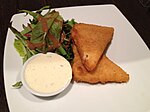Lemovician people
Мендієн Mendien | |
|---|---|
 Lemovician cultural celebration with children | |
| Total population | |
| ~2,000,000 | |
| Regions with significant populations | |
| 1,076,108 | |
| 119,978 | |
| Languages | |
| Lemovician and Miersan | |
| Religion | |
| Episemialism, historically Bogomilism | |
The Lemovicians (Lemovician: Мендіко єндея, Mendiko jendea) are a Euclean ethnic group and indigenous people native to Lemovicia and its immediate border regions.
History
Evidence of habitation of present-day Lemovicia dates back between 16,000 BCE and 12,500 BCE, with many Lemovicians claiming that they are the descendants of the proto-Euclean inhabitants who resided in Lemovicia. However, the exact origins of the Lemovicians are unclear, although it is known that they were referred in the Solarian Empire as the Menes.
(TBC)
Culture
Art
Cuisine
Traditionally, Lemovician cuisine is dictated by the geography of Lemovicia. The most popular Lemovician foods eaten as part of a meal include xerra and gazta gogorra, as well as solomo, while the most popular desserts are goxoa and ospakizun.
However, due to the geography of the country, there is considerable variation between the highlands and lowlands in terms of Lemovician cuisine. In the highlands, for example, txoriak arrautzarekin is consumed, while in the lowlands, txoriak kixona is consumed. Bread is also far more present in lowland Lemovician cuisine than in highland Lemovician cuisine.
Traditionally, Lemovicians have two main meals: breakfast (Lemovician: ґосарія, gosaria), which is the most important meal of the day, and traditionally consumed around dawn, and dinner (афарія, afaria), consumed around sunset, with a light meal, or tea (мокаду, mokadu) consumed around noon. However, as globalisation reaches Lemovicia, Lemovicians are starting to have three meals a day.
Religion
Prior to the arrival of Sotirianity in Lemovicia, the Lemovicians followed a traditional religion. However, following the arrival of Sotirianity, the Lemovicians became more aligned with the teachings of the Episemialists: by the tenth century, they embraced Bogomilism, which remained the dominant religion among the Lemovicians until the iconophilic victory in the Iconoclast Wars: however, Bogomilism persisted in the remote valleys of Lemovicia until at least the middle of the eighteenth century.
Today, virtually all ethnic Lemovicians are adherents to the Episemialist Church, with Episemialism playing an influential role in shaping Lemovician culture and identity.
Society
Lemovician society is traditionally characterised by a system of clans (Lemovician: агаіда, ahaida, plural: агаіде, ahaide), with each clan traditionally based off a central baserri, with further baserria being established as the clan grew in size and stature.
Inheritance was traditionally patrilineal, with the eldest son inheriting the baserri, and all younger sons inheriting any other properties owned by that branch of the clan. Over time, as clans grew in size, younger sons are forced to split off from their native clan and either join a new clan, or establish their own clan.
Sports
Traditionally, Lemovicians played traditional Lemovician sports, with the most popular traditional sports that continue to be played by the Lemovician community including Harri-jasotzaileak, sokatira, oilar jokoa, and the national sport of Lemovicia, pilota.
However, due to rule by foreign powers, such as Miersa and Narozalica, sports such as basketball, ice hockey, and football have gained popularity among the Lemovician community.

